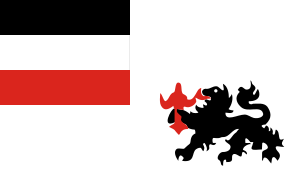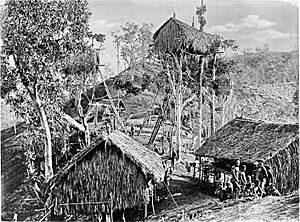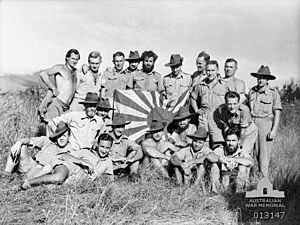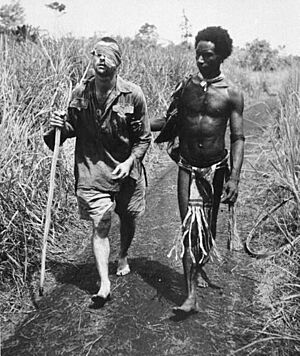History of Papua New Guinea facts for kids
The early history of Papua New Guinea began around 50,000 to 60,000 years ago. This was when the first people traveled to the Australian continent. Written history started when European sailors first saw New Guinea in the early 1600s.
Contents
Ancient Times in Papua New Guinea
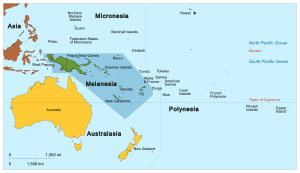
Scientists believe that people arrived in New Guinea about 60,000 years ago. They likely came by sea from Southeast Asia during the Last Glacial Period. At that time, sea levels were lower, making distances between islands shorter.
The first people were hunters and gatherers. But early signs show they also managed the forests to find food. There is also proof of early farming at a place called Kuk. This happened around the same time farming began in places like Mesopotamia and Egypt.
Today, important foods are sweet potatoes and pigs. These arrived later. But people living near the coast have always eaten shellfish and fish. Recent studies suggest that 50,000 years ago, people lived in the highlands. They were at heights of up to 2,000 meters (6,560 feet). This means they were not only living in warmer coastal areas.
Europeans Arrive

When Europeans first came, the people of New Guinea and nearby islands had good farming systems. They used tools made from bone, wood, and stone. They traded goods like pottery, shell jewelry, and food along the coast. In the middle of the island, they traded forest products for shells and other sea items.
The first Europeans to see New Guinea were probably Portuguese and Spanish sailors. This happened in the early 1500s. In 1526–1527, the Portuguese explorer Jorge de Menezes found the main island by accident. He is said to have named it "Papua." This name comes from a Malay word for the curly hair of the Melanesian people.
In 1545, the Spaniard Yñigo Ortiz de Retez called the island "New Guinea." He thought the people looked like those on the African Guinea coast. Even though European sailors visited the islands, not much was known about the people until the 1870s. That's when Russian scientist Nicholai Miklukho-Maklai lived among the local tribes for several years. He wrote detailed descriptions of their lives.
British and Australian Control
In 1883, the Colony of Queensland (part of Australia) tried to take over the southern half of eastern New Guinea. But the British government did not agree. However, when Germany started setting up settlements in the north, Britain declared a protectorate in 1884. This was over the southern coast of New Guinea and its nearby islands.
This protectorate was called British New Guinea. It officially became a British territory on September 4, 1888. In 1902, it was put under the control of Australia. After the Papua Act was passed in 1905, British New Guinea became the Territory of Papua. Australia officially started managing it in 1906. Papua remained under British control until Papua New Guinea became independent in 1975.
There was not much economic activity in Papua. Australia managed it separately until Japan invaded in 1941. During the Pacific War, an Australian military government ruled Papua from Port Moresby.
German New Guinea
In the late 1800s, Europe wanted more coconut oil. So, a large German trading company called Godeffroy's of Hamburg started trading for copra (dried coconut meat) in the New Guinea Islands. In 1884, the German Empire officially took control of the northeast part of the island. They gave its management to a trading company called the German New Guinea Company.
This company was allowed to act like a government over the land. They could even make agreements with the local people. The German government still handled relationships with other countries. The company paid for the local government. In 1899, the German government took direct control of the territory. It was then known as German New Guinea.
New Guinea was mainly a business project for Germany. Thousands of local workers were hired for low pay on cocoa and copra farms. Education was provided by missionaries. When World War I started in 1914, Australia took over the German colony. The farms were given to Australian soldiers who fought in the war. In 1921, the League of Nations (an international group) gave Australia control over New Guinea. The farms and gold mining brought some wealth to the area.
Territory of New Guinea

In 1920, Australia was given the job of governing the former German territory of New Guinea by the League of Nations. Australia managed it until the Japanese invasion in December 1941. Much of the Territory of New Guinea, including Bougainville and New Britain, was taken over by Japanese forces. Australian and American forces later recaptured these areas during the last months of the war.
Exploring the Land
Exploring Papua New Guinea has been an ongoing process. Even in recent years, new groups of people have been contacted. For a long time, exploration was not planned. It was often done by miners, missionaries, and adventurers looking for different things. Many of these people were focused on doing, not writing down facts. So, our knowledge of the exploration has not always kept up with the actual discoveries.
One example is the Akmana Gold Prospecting Company's Field Party. They went on two expeditions in 1929 and 1930. They traveled by boat up the Sepik River and then by smaller boats and on foot into the mountains. They were looking for gold but did not find enough to make it worthwhile. These expeditions helped map out parts of the country and made contact with many local groups. The explorers tried to build good relationships through fair trade.
World War II in Papua New Guinea
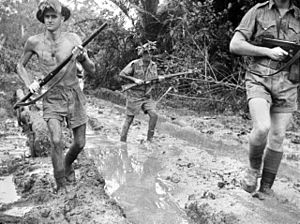
Soon after the Pacific War began, Japan invaded the island of New Guinea. Most of West Papua (then called Dutch New Guinea) was taken over. Large parts of the Territory of New Guinea were also occupied. However, Papua was mostly safe because of its southern location and the very difficult Owen Stanley Ranges to the north.
The New Guinea campaign started with battles in New Britain and New Ireland in 1942. Rabaul, the capital of the Territory, was taken by Japan. It became a major Japanese base. From there, they landed on mainland New Guinea and moved towards Port Moresby and Australia.
After their attempt to capture Port Moresby by sea failed, the Japanese tried to invade by land. They used the Kokoda Trail. From July 1942, Australian soldiers fought hard against the Japanese advance along the Kokoda Track. This trail went over the rough Owen Stanley Ranges towards Port Moresby. Local Papuans, known as Fuzzy Wuzzy Angels, helped and guided injured Australian troops down the trail.
The Japanese were pushed back. Then came the tough Battle of Buna-Gona. Australian and United States forces attacked the main Japanese landing sites in New Guinea. These were at Buna, Sanananda, and Gona. The Allied forces faced tropical diseases, difficult land, and strong Japanese defenses. They won, but with many losses.
In September 1942, Japanese marines attacked an important Australian air base at Milne Bay. This was near the eastern tip of Papua. The Australian Army pushed them back. The Battle of Milne Bay is remembered as the first clear defeat for Japanese land forces in World War II.
The fighting in Papua and New Guinea from 1943–44 was the biggest series of operations ever by the Australian military. The main commander was U.S. General Douglas MacArthur. Australian General Thomas Blamey was directly involved in planning. Hard fighting continued in New Guinea until Japan surrendered in 1945. Around 200,000 Japanese soldiers, sailors, and airmen died in this campaign. About 7,000 Australian and 7,000 American service members also died.
Towards Independence
After Japan surrendered in 1945, Australia took back control of Papua and New Guinea. They were combined into one administrative area. In 1949, the Papua and New Guinea Act 1949 officially put New Guinea under the United Nations. It also confirmed the combined administration as The Territory of Papua and New Guinea.
This Act created a Legislative Council in 1951, a court system, a public service, and local governments. Sir Donald Cleland was the administrator. In 1963, the House of Assembly of Papua and New Guinea replaced the Legislative Council. After elections in 1964, it opened on June 8. In 1972, the territory's name was changed to Papua New Guinea.
Australia's approach to Papua New Guinea changed after the World Bank visited in 1964. The bank advised on how to help the country grow its economy and prepare for self-rule. This report guided much of the economic policy leading up to independence.
Becoming an Independent Nation
Elections in 1972 led to a government led by Chief Minister Michael Somare. He promised to guide the country to self-government and then to independence. Papua New Guinea became self-governing on December 1, 1973. It then achieved full independence on September 16, 1975. The country joined the United Nations (UN) shortly after, on October 10, 1975.
The 1977 elections confirmed Michael Somare as Prime Minister. However, his government later lost a vote in 1980 and was replaced by a new leader, Sir Julius Chan. Over the years, Papua New Guinea's politics have seen many changes in leadership. New governments are now protected from no-confidence votes for their first 18 months.
A nine-year conflict happened on the island of Bougainville. It caused about 20,000 deaths. The fighting began in 1989 and ended with a peace agreement in 2001. This agreement created the Bougainville Autonomous District and Province. The people of Bougainville will have a vote on independence sometime before mid-2020.
Many Chinese people have lived and worked in Papua New Guinea for a long time. In May 2009, there were riots involving many people. This happened after a fight between Chinese and Papua New Guinean workers at a factory. Some local people were unhappy about Chinese ownership of many small businesses.
In 2018, a series of earthquakes hit Papua New Guinea. This caused a lot of damage. Countries like Australia and New Zealand quickly sent help.
In May 2019, James Marape became the new prime minister. He had been a key minister in the previous government. In July 2022, Prime Minister James Marape's PANGU Party won the most seats in the election. This meant James Marape continued as PNG's Prime Minister.
On January 10, 2024, a riot broke out in Port Moresby. Shops were burned, cars were set on fire, and supermarkets were looted. Riots also happened in the city of Lae. 22 lives were lost. These riots started after police and public sector workers protested over their pay. Prime Minister James Marape declared a 14-day state of emergency.
See also
 In Spanish: Historia de Papúa Nueva Guinea para niños
In Spanish: Historia de Papúa Nueva Guinea para niños



